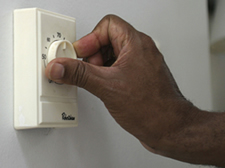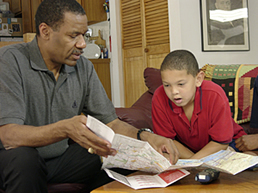HOME PREVENTION | HOME SAFETY | FIRE PREVENTION

HOME FIRE SAFETY
When the weather outside is frightful, keep fires delightful and safe
Precautions and preparations for ensuring safety when using alternative heat sources
Arindam Mukherjee , Staff Writer, RedCross.org
Dropping temperatures across the country this time of year typically prompt a rise in the use of alternative heat sources such as fireplaces, wood or coal-burning stoves and space heaters to stay warm, and unfortunately can result in an increase in the number of home fire incidents.

While alternative heat sources can cut costs as temperatures go down and heating bills go up, they could cost you more than most expect if they’re not used with care and caution.
(Photo Credit: Hector Emanuel/American Red Cross Stock)
A recent American Red Cross poll found that nearly half of American families use alternative sources to heat their homes when the weather turns cold and frightful. Home heating remains the second highest cause of home fires at 26 percent, but even more chilling than the frosty weather is that they are the most deadly fires, according to the National Fire Protection Association, which reports that 73 percent of fire deaths were related to home heating in 2003.
Safety isn’t seasonal, but when cold weather sets in, certain precautions are in order when and if alternative heating sources are used. To help the public stay safe while they’re staying warm, the Red Cross offers the following recommendations for preventing home heating fires while urging families to develop a home fire escape plan.
Simple Tips to Prevent Home Heating Fires
- Fireplace Safety: Keep fire in the fireplace by using glass or metal fire screens. Never leave a fire in the fireplace unattended, extinguish the fire before going to bed or leaving the house and provide constant adult supervision in rooms with fires lit.
- Call a professional: Have wood and coal stoves, fireplaces and chimneys inspected annually by a professional and cleaned, if necessary.
- Appliances for cooking, not heating: Always follow the directions for using appliances that generate heat, keep them clear of flammable materials and never use a cooking range or oven to heat your home.
- Do not feed the fire: Keep all flammable materials and potential fuel sources – including but not limited to old newspapers, matches, bedding, clothing, carpets and rugs – at least three feet away from heat sources such as space heaters, fireplaces and stoves.
- Space heaters: Whether operating on electricity, gas, kerosene, coal or wood, read and follow the manufacturer’s instructions on how, when and where to safely use them. If you must use space heaters, place them on a level, hard and nonflammable surface such as ceramic tile floor – not on rugs or carpets or near bedding or drapes. Turn off portable space heaters every time you leave the room or go to sleep. Keep children and pets away from space heaters.
Other Fire Factors
Another major cause of home fires is candles, accounting for more than 23,600 residential fires each year, reports the U.S. Fire Administration (USFA). Red Cross preparedness expert Keith Robertory notes that, although candles often play a role in holiday traditions and can create a warm, cozy atmosphere, they also can be extremely dangerous.
“Avoiding the use of candles can be one of the most important precautions families can take during the holidays,” said Robertory. “Never leave burning candles unattended and extinguish all candles before leaving the room.”
General Fire Safety Preparedness and Safety
According to the National Fire Protection Association, a home fire is reported every 79 seconds in the United States, and someone dies from a fire every 135 minutes. Further illustrating what those numbers mean, the Centers for Disease Control and Prevention reports that fires kill more Americans each year than all natural disasters combined. Yet, a survey by the Red Cross indicates that four out five (80 percent) Americans are unaware that fires are the most common disaster in the U.S. while only one in four (26 percent) households have a home fire escape plan. It is important to make a home fire escape and include children in the discussion so they know what to do too. While all families should make fire safety and preparedness a priority, it is especially important for African Americans, who are disproportionately more affected by home fires. According to the U.S. Census Bureau, African Americans make up less than 13 percent of the U.S. population but represent 25 percent of all fire deaths, according to the USFA. know what to do too. While all families should make fire safety and preparedness a priority, it is especially important for African Americans, who are disproportionately more affected by home fires. According to the U.S. Census Bureau, African Americans make up less than 13 percent of the U.S. population but represent 25 percent of all fire deaths, according to the USFA.
(Photo Credit: Hector Emanuel/American Red Cross Stock)
Precautions, prevention and preparedness are important for all households to ensure year-round fire safety at home.
“The good news is that preparing for a home fire doesn’t require a lot of expensive equipment or training,” said another Red Cross preparedness expert Heidi Taylor.
One way to prepare is to install smoke alarms and check regularly to ensure that all smoke alarms in the home are functioning properly. Having a working smoke alarm reduces one’s chance of dying in a fire by nearly half, according to the USFA.
“In addition to functioning smoke alarms, one of the easiest ways to prepare is to develop and practice a home fire escape plan so that every family member, including young children and the elderly, can escape quickly and safely,” said Taylor.
Home fire escape plans should include provisions for any household member who may have mobility, sight or hearing concerns that make exiting quickly a challenge. Red Cross further recommends that fire escape plans include at least two exit routes for every room in the home, and a convenient meeting place at a safe distance from the fire.
Finally, consider keeping one or more working fire extinguishers in your home and getting training from the fire department in how to use them. Models available for home use today are both compact and affordable.
For more information about fire prevention and safety, visit www.redcross.org/homefires. To learn more about overall home, community and workplace preparedness, go to the “Get Prepared” section of RedCross.org.
Leigh-Anne Dennison contributed to this article.
All American Red Cross disaster assistance is free, made possible by voluntary donations of time and money from the American people. You can help the victims of thousands of disasters across the country each year by making a financial gift to the American Red Cross Disaster Relief Fund, which enables the Red Cross to provide shelter, food, counseling and other assistance to victims of disaster. The American Red Cross honors donor intent. If you wish to designate your donation to a specific disaster, please do so at the time of your donation. Call 1-800-REDCROSS or 1-800-257-7575 (Spanish). Contributions to the Disaster Relief Fund may be sent to your local American Red Cross chapter or to the American Red Cross, P. O. Box 37243, Washington, DC 20013. Internet users can make a secure online contribution by visiting www.redcross.org.
Article reproduce for community education and in suppport to our local Red Cross |

![]()
 info
info

 know what to do too. While all families should make fire safety and preparedness a priority, it is especially important for African Americans, who are disproportionately more affected by home fires. According to the U.S. Census Bureau, African Americans make up less than 13 percent of the U.S. population but represent 25 percent of all fire deaths, according to the USFA.
know what to do too. While all families should make fire safety and preparedness a priority, it is especially important for African Americans, who are disproportionately more affected by home fires. According to the U.S. Census Bureau, African Americans make up less than 13 percent of the U.S. population but represent 25 percent of all fire deaths, according to the USFA.